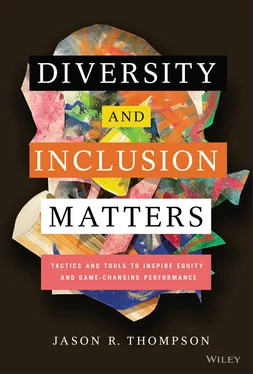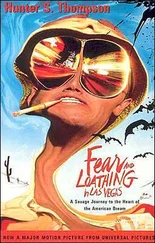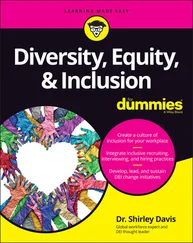Jason R. Thompson - Diversity and Inclusion Matters
Здесь есть возможность читать онлайн «Jason R. Thompson - Diversity and Inclusion Matters» — ознакомительный отрывок электронной книги совершенно бесплатно, а после прочтения отрывка купить полную версию. В некоторых случаях можно слушать аудио, скачать через торрент в формате fb2 и присутствует краткое содержание. Жанр: unrecognised, на английском языке. Описание произведения, (предисловие) а так же отзывы посетителей доступны на портале библиотеки ЛибКат.
- Название:Diversity and Inclusion Matters
- Автор:
- Жанр:
- Год:неизвестен
- ISBN:нет данных
- Рейтинг книги:3 / 5. Голосов: 1
-
Избранное:Добавить в избранное
- Отзывы:
-
Ваша оценка:
- 60
- 1
- 2
- 3
- 4
- 5
Diversity and Inclusion Matters: краткое содержание, описание и аннотация
Предлагаем к чтению аннотацию, описание, краткое содержание или предисловие (зависит от того, что написал сам автор книги «Diversity and Inclusion Matters»). Если вы не нашли необходимую информацию о книге — напишите в комментариях, мы постараемся отыскать её.
Diversity and Inclusion Matters: Tactics and Tools to Inspire Equity and Game-Changing Performance,
Diversity and Inclusion Matters
Diversity and Inclusion Matters — читать онлайн ознакомительный отрывок
Ниже представлен текст книги, разбитый по страницам. Система сохранения места последней прочитанной страницы, позволяет с удобством читать онлайн бесплатно книгу «Diversity and Inclusion Matters», без необходимости каждый раз заново искать на чём Вы остановились. Поставьте закладку, и сможете в любой момент перейти на страницу, на которой закончили чтение.
Интервал:
Закладка:
7 7. The seven most embarrassing branding mistakes of 2018 were chronicled by Brit Morse in an article for INC. The majority were culturally, racially, or ethnically insensitive and offensive. Accessed on April 7, 2020, at https://www.inc.com/brit-morse/2018-biggest-marketing-branding-fails.html
8 8. Sam Dean and Johana Bhuiyan, writing for the Los Angeles Times on June 14, 2020, called out the tech industry for lacking diversity and for being far less than transparent about it, entitled “Why are Black and Latino people still left out of the tech industry?” the article primarily reports on diversity at Google, who released the data on racial and gender diversity of their workforce demographic data in 2014, but the lack of diversity throughout the tech industry is evidenced. Accessed on April 7, 2020 at https://www.latimes.com/business/technology/story/2020-06-24/tech-started-publicly-taking-lack-of-diversity-seriously-in-2014-why-has-so-little-changed-for-black-workers
9 9. Tina Shah Paikeday, “A Leader's Guide: Finding and Keeping Your Next Chief Diversity Officer,” Russell Reynolds. Accessed June 23, 2021, at: https://www.russellreynolds.com/insights/thought-leadership/a-leaders-guide-finding-and-keeping-your-next-chief-diversity-officer
10 10. Chip Cutter and Lauren Weber commented on the future of work for, and the turnover of, Diversity Officers on July 13, 2020 in an article for the Wall Street Journal. They noted, “It's one of the hottest jobs in America – and it has a revolving door.” Accessed on April 7, 2021 at https://www.wsj.com/articles/demand-for-chief-diversity-officers-is-high-so-is-turnover-11594638000
Chapter 2 DE&I Fundamentals, CAPE, and Organizational Change
Overwhelmed and Needing a Process
When I was a graduate student at the University of Wyoming, I remember being overwhelmed with the thought of starting my thesis. It had to be over 100 pages and, in some way, add to the field of study. At that point in my life, I had never even written more than ten pages, so writing 100 pages seemed like an impossible task for me. I remember thinking, Why did I even start this graduate program ?!? There was no way I could write 100 pages of anything. I had no idea where to start or even what to start researching. With my history of being a slow reader and terrible writer, the task was way too big, and I stopped doing anything.
As luck would have it, a faculty member, Dr. Garth Massey, saw me struggling and told me a story I will never forget. I often reflect on this story when I begin to feel immobilized by a task that seems too big. Dr. Massey shared a parable with me about a parent, their young child, and a large walnut tree.
As this story goes, the child (who was about six years old) was called out to the front yard of the home where there was a large walnut tree. The parent pointed to the walnuts that had fallen out of the tree and said to the small child, “You need to pick up all these walnuts.”
Apparently, this tree was quite large, and there were walnuts everywhere. I did a quick Google search and found that a mature walnut tree can produce up to 350 lbs. of nuts. The average nut weighs between five to ten grams and there are 454 grams in a pound. You can do the math here, but that is a lot of walnuts!
As you can imagine, the young child looked at the tree, looked at the walnuts all over the front yard, and was immediately overwhelmed by the task. The small child knew immediately this task was too big and they would never be able to pick up all the walnuts. Without responding, the child began to cry. The child was overwhelmed by the task. I could relate to this child as I, too, was immobilized by the task of writing my graduate theses. It was just too big.
The parent said to the child, “Go into the shed and get some string and seven stakes.”
The parent placed seven stakes evenly around the tree. They then tied the string from the tree to each of the seven stakes creating what looked like seven pieces of pie. They then looked at the child and said, “All you have to do is clear one section of the pie every day for seven days. At the end of seven days, you will have picked up all the walnuts.”
This helped me to get started on my graduate thesis, as it reminded me that you don't write the thesis in one day. Most importantly you have to break the task into manageable pieces in order to get started. You need a plan.
Over my career, I have launched four diversity, equity, and inclusion (DE&I) programs in four different industries, and I have often reminded myself of this story to help me get started and keep the faith that my work will bear fruit. When you start a DE&I program, there is typically little budget, no staff, and everyone wants everything fixed on day one. Things move slowly, and at times it feels as though nothing is moving. To keep momentum and track my progress, at the start of any DE&I program I remind myself and the people I'm working with to not get overwhelmed, stick to the plan, stay flexible, and realize we have been given a huge task. Much like the parent's advice in this parable, the CAPE process was designed to help you stay on task and identify which section needs to be picked up first. Not everything will get done on day one, but keep working on the piece you need to fix on that day. Walnuts will keep falling, but you can use the CAPE process, create a plan, and stick to it.
In this chapter, I'll cover the basics of a DE&I program and talk about the two central aspects of DE&I work:
1 Establishing a shared language for DE&I
2 Recruitment and retention
Throughout this chapter, you will be introduced to a model for managing the change that DE&I brings into any organization so that you can set some stakes into the ground of your DE&I work.
The Basics of Every DE&I Program
Starting a DE&I program can feel overwhelming, a bit like that child standing at the foot of the walnut tree. Where to begin with such a huge task in front of you? Remember, this is also a big organizational shift for the company; therefore, much like the story above, start with simple tools and basics.
The goal of any DE&I program is cultural change. To change the culture of the organization, you need a shared language and understanding of where the company is going. I recommend two simple tools. First, take a moment to make sure everyone is using the same definitions (language) for diversity, equity, and inclusion. The second is using some basic organizational change theory. I use a model of organizational change developed by Jeff Hiatt called ADKAR. I will provide a simple understanding of the change management model that will prove to be very effective.
Shared Language (Basic Definitions)
By committing to a collective understanding of these definitions you can set expectations and know everyone is using the same fundamental understanding. Below are examples, but I would develop definitions that resonate with your company or organization.
Diversity: What do we look like? Diversity is about reflecting the mixture of differences and similarities that we find in the world and acknowledging the related tension as we strive to develop more inclusive and high-performing environments.
Equity: How do we treat each other and what are our policies to ensure equity? Equity is the principle of creating full access and removing barriers to participation. Equity is fair treatment, access, opportunity, and advancement for all people, while at the same time striving to identify and eliminate barriers that prevent the full participation of some groups.
Inclusion: Why we stay? Inclusion is about making people feel welcomed and valued. Inclusion is retention.
DE&I Change Management Model versus Diversity Training
Интервал:
Закладка:
Похожие книги на «Diversity and Inclusion Matters»
Представляем Вашему вниманию похожие книги на «Diversity and Inclusion Matters» списком для выбора. Мы отобрали схожую по названию и смыслу литературу в надежде предоставить читателям больше вариантов отыскать новые, интересные, ещё непрочитанные произведения.
Обсуждение, отзывы о книге «Diversity and Inclusion Matters» и просто собственные мнения читателей. Оставьте ваши комментарии, напишите, что Вы думаете о произведении, его смысле или главных героях. Укажите что конкретно понравилось, а что нет, и почему Вы так считаете.











